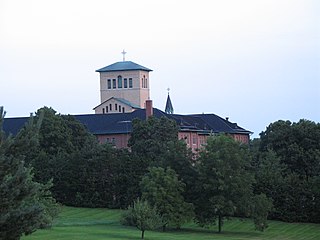
The Benedictines, officially the Order of Saint Benedict, are a mainly contemplative monastic religious order of the Catholic Church for men and for women who follow the Rule of Saint Benedict. The male religious are also sometimes called the Black Monks, in reference to the colour of their religious habits, in contrast to other Benedictine orders such as the Olivetans, who wear white. They were founded in 529 by Benedict of Nursia, a 6th-century Italian monk who laid the foundations of Benedictine monasticism through the formulation of his Rule. Benedict's sister, Scholastica, possibly his twin, also became a religious from an early age, but chose to live as a hermit. They retained a close relationship until her death.

Eucharistic adoration is a Eucharistic devotional practice primarily in Western Catholicism, but also to a lesser extent in certain Lutheran and Anglican traditions, in which the Blessed Sacrament is adored by the faithful. This practice may occur either when the Eucharist is exposed, or when it is not publicly viewable because it is reserved in a place such as a church tabernacle.

Perpetual prayer is the Christian practice of continuous prayer carried out by a group.

The Benedictine Sisters of Perpetual Adoration are a congregation of sisters that follow the Rule of St. Benedict and practice daily Eucharistic adoration. Their monastery is located in Clyde, Missouri.

Maria Rickenbach Monastery is a Benedictine monastery of Religious Sisters. It is situated in the village of Niederrickenbach in the municipality of Oberdorf in the Swiss canton of Nidwalden. It is accessible to the public only by cable car from Niederrickenbach Station on the Luzern–Stans–Engelberg railway line, although there is a private road leading up to the village from Dallenwil.

The Holy Spirit Adoration Sisters are a Catholic religious institute. The nuns live a contemplative life, focused on perpetual adoration of the Blessed Sacrament, offering intercessory prayers for the world 24 hours a day. Inside the enclosure the nuns wear rose-colored tunics with their habits symbolizing their joy for the Holy Spirit. As a consequence of these habits, the nuns are known colloquially as the "pink sisters".
The Poor Clares of Perpetual Adoration (PCPA) are a branch of the Poor Clares, a cloistered, contemplative order of nuns in the Franciscan tradition. Founded in France in 1854 by Marie Claire Bouillevaux, the Poor Clares of Perpetual Adoration are cloistered nuns dedicated to the perpetual adoration of the Blessed Sacrament.
The Tabernacle Societies were lay Eucharistic Adorative associations within Roman Catholic parishes, principally in America and Australia, forming part of the Archassociation of the Eucharist under the guidance of the Association of Perpetual Adoration of the Blessed Sacrament.

The Diocese of Saint-Dié (Latin: Dioecesis Sancti Deodatiis; French: Diocèse de Saint-Dié is a Latin Church ecclesiastical territory or diocese of the Catholic Church in France. The diocese has the same boundaries as the département of the Vosges. The bishop's cathedra is Saint-Dié Cathedral in the town now named Saint-Dié-des-Vosges, but since 1944 has lived in Épinal, capital of the département. The Diocese of Saint–Dié is a suffragan diocese in the ecclesiastical province of the metropolitan Archdiocese of Besançon.

The Kotowski Palace was a 17th-century palace in Warsaw, Poland. It served as the main cloister building for the Benedictine Sisters of Perpetual Adoration.

The Servants of the Blessed Sacrament is a Roman Catholic contemplative, but not cloistered, congregation of sisters with a focus on Eucharistic adoration.
The Sisters of the Blessed Sacrament and Our Lady is an enclosed religious order and a reform of the Dominican Order devoted to the perpetual adoration of the Blessed Sacrament. The congregation was founded in Marseille in 1659 by a Dominican priest, Anthony Le Quieu.
The Order of the Annunciation of the Blessed Virgin Mary, also known as Sisters of the Annunciation or Annonciades, is an enclosed religious order of contemplative nuns founded in honor of the Annunciation in 1501 at Bourges by Joan de Valois, also known as Joan of France, daughter of King Louis XI of France, and wife of Louis, the Duke of Orléans, later King Louis XII of France.

Mechtilde of the Blessed Sacrament, born Catherine de Bar was a French nun, the founder of the order of Benedictine Nuns of Perpetual Adoration of the Blessed Sacrament. She is recognized as the Servant of God in the Catholic Church.
The Religious of the Perpetual Adoration was a religious congregation of the Catholic Church. It was founded by Sister Elizabeth Zwirer, in Einsiedeln, Switzerland, 1526, following the Benedictine rule.

The Tyburn Nuns, formally, Adorers of the Sacred Heart of Jesus of Montmartre, is a Catholic congregation of Benedictine nuns. The congregation was originally founded in Paris but was obliged to find a new Mother House due to French legislation passed in 1901. Two years later it relocated to London and subsequently established additional convents in nine other countries. The nuns at the London convent practice the Perpetual Adoration of the Blessed Sacrament and maintain a shrine dedicated to the Catholic martyrs of the English Reformation.

Silverstream Priory is a Roman Catholic monastery in Stamullen, County Meath, Ireland, founded in 2012. The monastery is an autonomous diocesan priory of the Benedictine Monks of Perpetual Adoration.
The Order of the Blessed Sacrament is an enclosed congregation and a reform of the Dominican Order devoted to the perpetual adoration of the Blessed Sacrament.

Irena Maria "Ika" Popiel was a Polish nun who served at the order of the Benedictine Nuns of Perpetual Adoration of the Blessed Sacrament, and was a prioress of the order's convent in Warsaw, as well as the initiator and co-founder of the Conference of Superiors of Female Confraternity Monasteries in Poland.

Gertrud Leupi OSB, was a Swiss Benedictine and founder of monasteries. She founded the Maria Rickenbach Monastery, Switzerland, the Yankton Benedictine, South Dakota, and the Marienburg monastery, Wikon, Switzerland.














